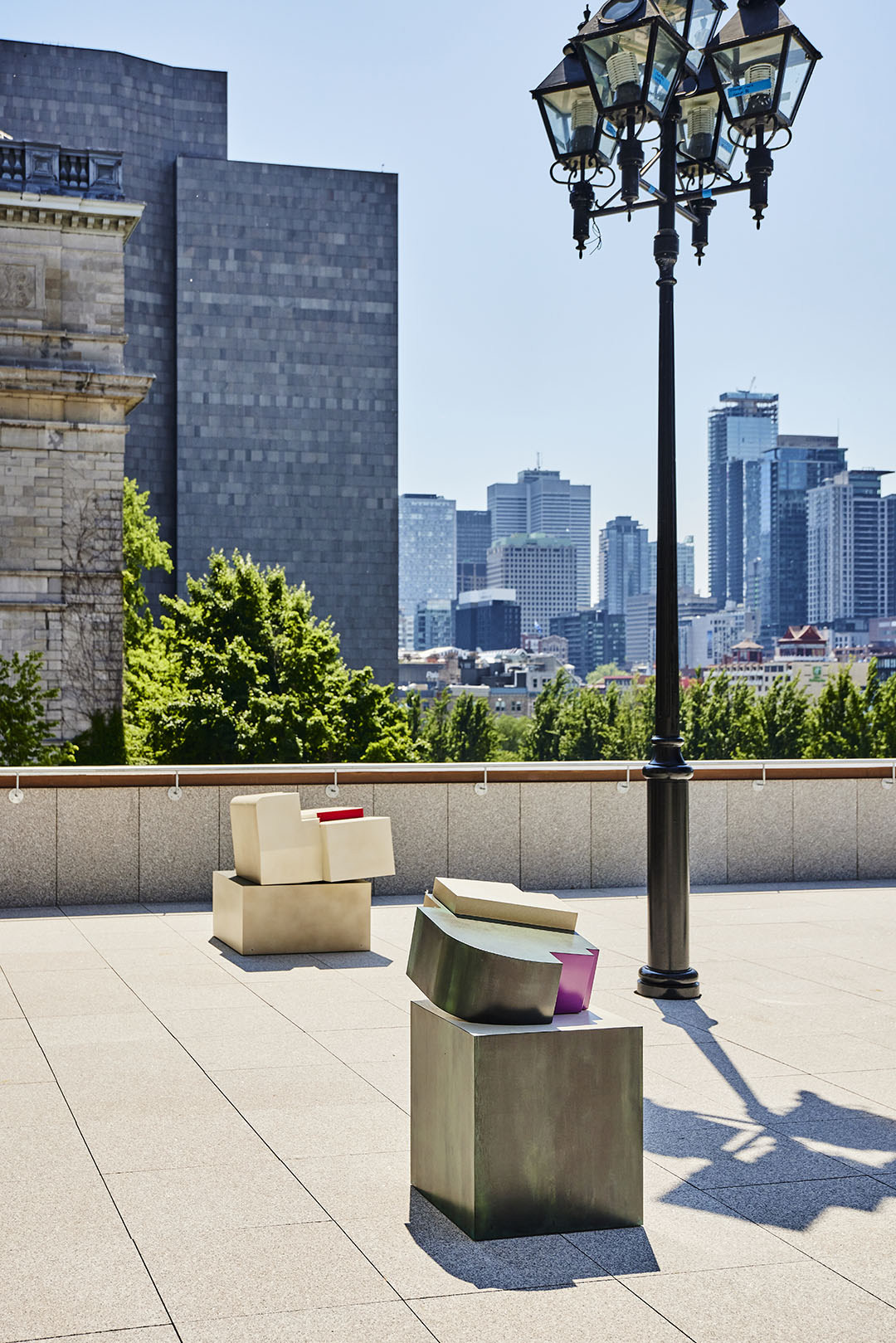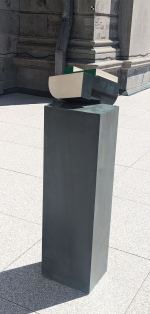Mathieu Lévesque
Gambit
2024
Presentation of the artwork
Gambit is a group of five sculptures underlining the the historical identities of Montréalers. Composed of architectural elements typical of the city, such as balconies, staircases, and patios, the sculptures embody audacity through their incongruous positions, which also evoke the city’s geography as an island. The progressing height of the pedestals represents the fair, egalitarian nature of our society. The white and bronze illustrate our mixed identity, often containing dualities, and the small coloured surfaces refer to the symbols on the flag and coat of arms of Montréal. The number of sculptures reflect the city’s five founding peoples and also respond to the architecture of the building’s façade, which is composed of five sections and five stained-glass windows. The works are arranged in ascending order of volume and in reverse order of the arrival of each founding people in the area.
· White pine for Indigenous peoples – Yellow
· Fleur de lys for the French – Blue
· Rose for the English – Red
· Thistle for the Scottish – Purple
· Clover for the Irish – Green
Associated events
This artwork was created as part of the major construction and renovation project for Montréal’s city hall, situated in the Ville-Marie borough. It was produced under the Québec government’s Politique d’intégration des arts à l’architecture et à l’environnement des bâtiments et des sites gouvernementaux et publics.
Mathieu Lévesque
Mathieu Lévesque holds a BA and an MA in visual and media arts from the Université du Québec à Montréal; he has also studied art history. In his work, Lévesque explores the elementary components of painting and sculpture and their proximity with their immediate environment. He strives to broaden the limits of the disciplines of painting, sculpture, and architecture, while highlighting their respective aesthetic, material, and spatial uniqueness. His works have been shown in Québec, Canada, the United States, Germany, and Belgium.
Presentation of the artwork
Gambit is a group of five sculptures underlining the the historical identities of Montréalers. Composed of architectural elements typical of the city, such as balconies, staircases, and patios, the sculptures embody audacity through their incongruous positions, which also evoke the city’s geography as an island. The progressing height of the pedestals represents the fair, egalitarian nature of our society. The white and bronze illustrate our mixed identity, often containing dualities, and the small coloured surfaces refer to the symbols on the flag and coat of arms of Montréal. The number of sculptures reflect the city’s five founding peoples and also respond to the architecture of the building’s façade, which is composed of five sections and five stained-glass windows. The works are arranged in ascending order of volume and in reverse order of the arrival of each founding people in the area.
· White pine for Indigenous peoples – Yellow
· Fleur de lys for the French – Blue
· Rose for the English – Red
· Thistle for the Scottish – Purple
· Clover for the Irish – Green
Associated events
This artwork was created as part of the major construction and renovation project for Montréal’s city hall, situated in the Ville-Marie borough. It was produced under the Québec government’s Politique d’intégration des arts à l’architecture et à l’environnement des bâtiments et des sites gouvernementaux et publics.
Mathieu Lévesque
Mathieu Lévesque holds a BA and an MA in visual and media arts from the Université du Québec à Montréal; he has also studied art history. In his work, Lévesque explores the elementary components of painting and sculpture and their proximity with their immediate environment. He strives to broaden the limits of the disciplines of painting, sculpture, and architecture, while highlighting their respective aesthetic, material, and spatial uniqueness. His works have been shown in Québec, Canada, the United States, Germany, and Belgium.






